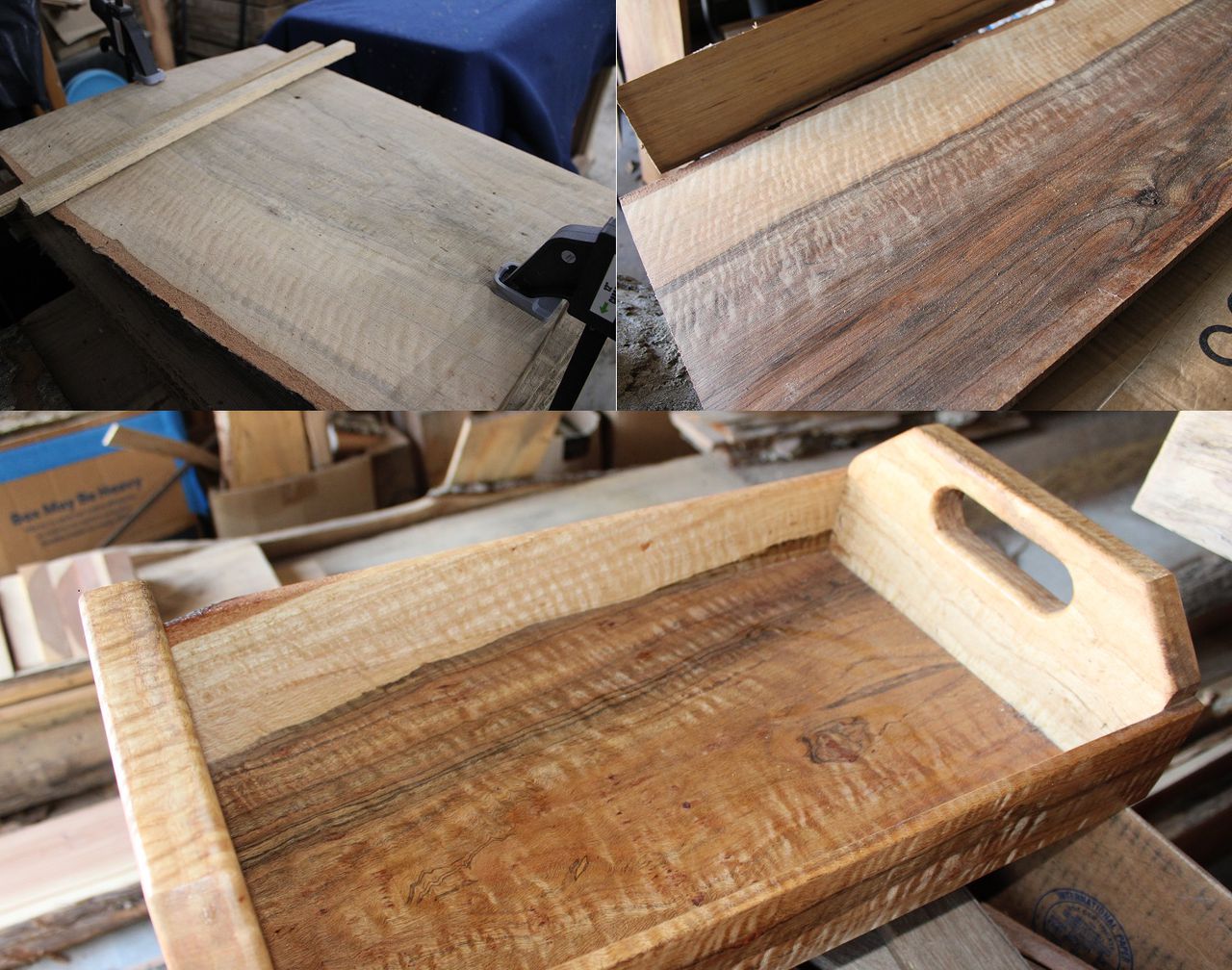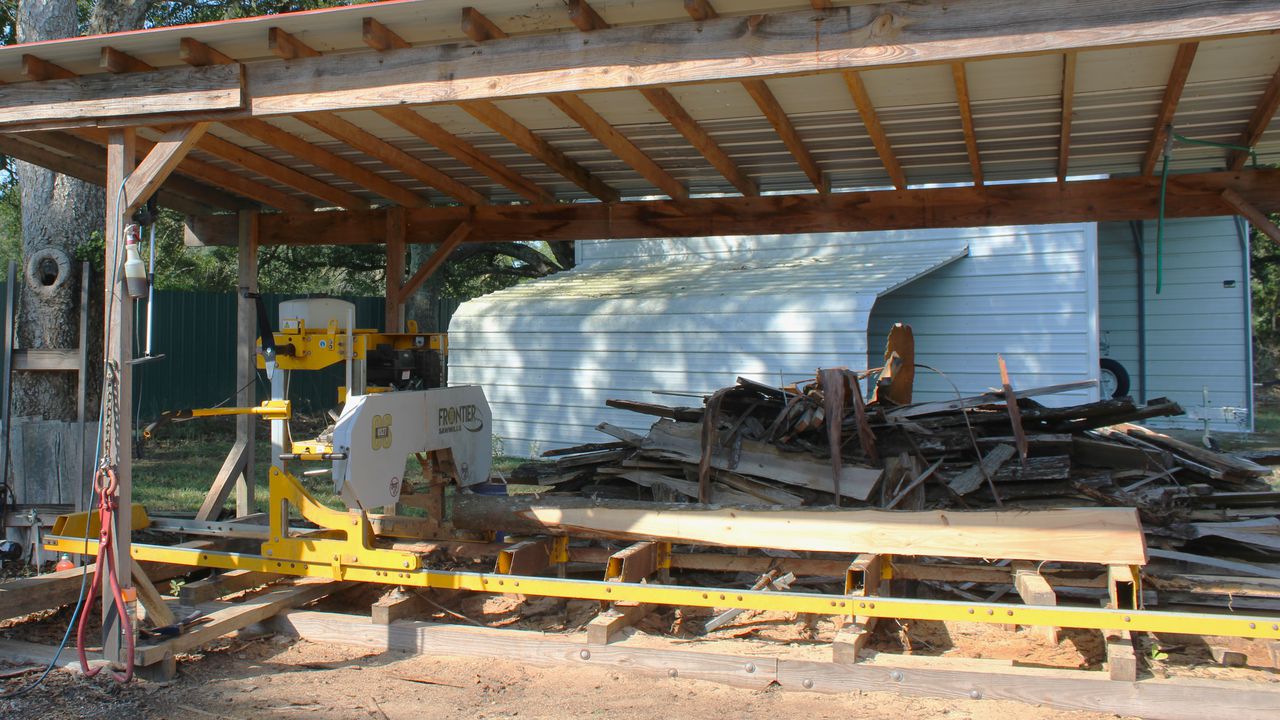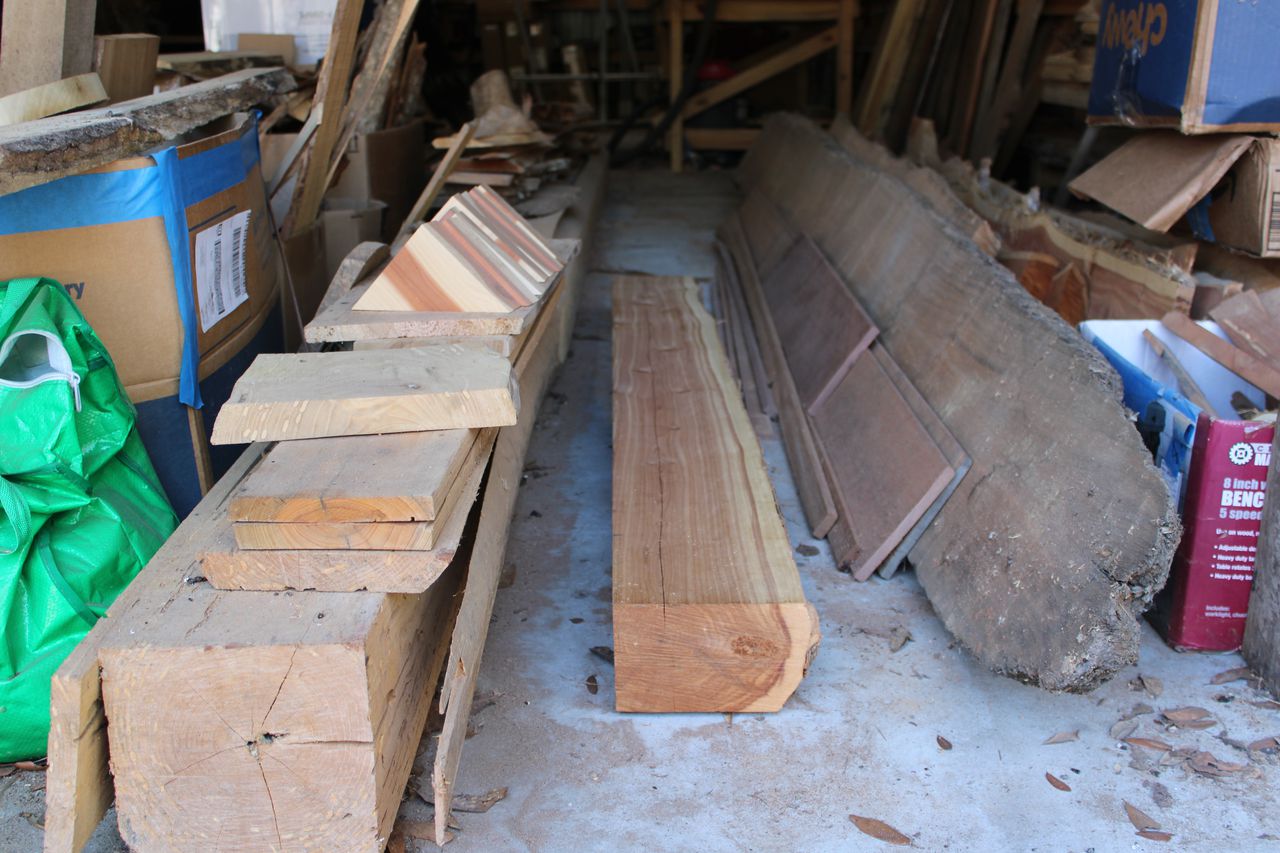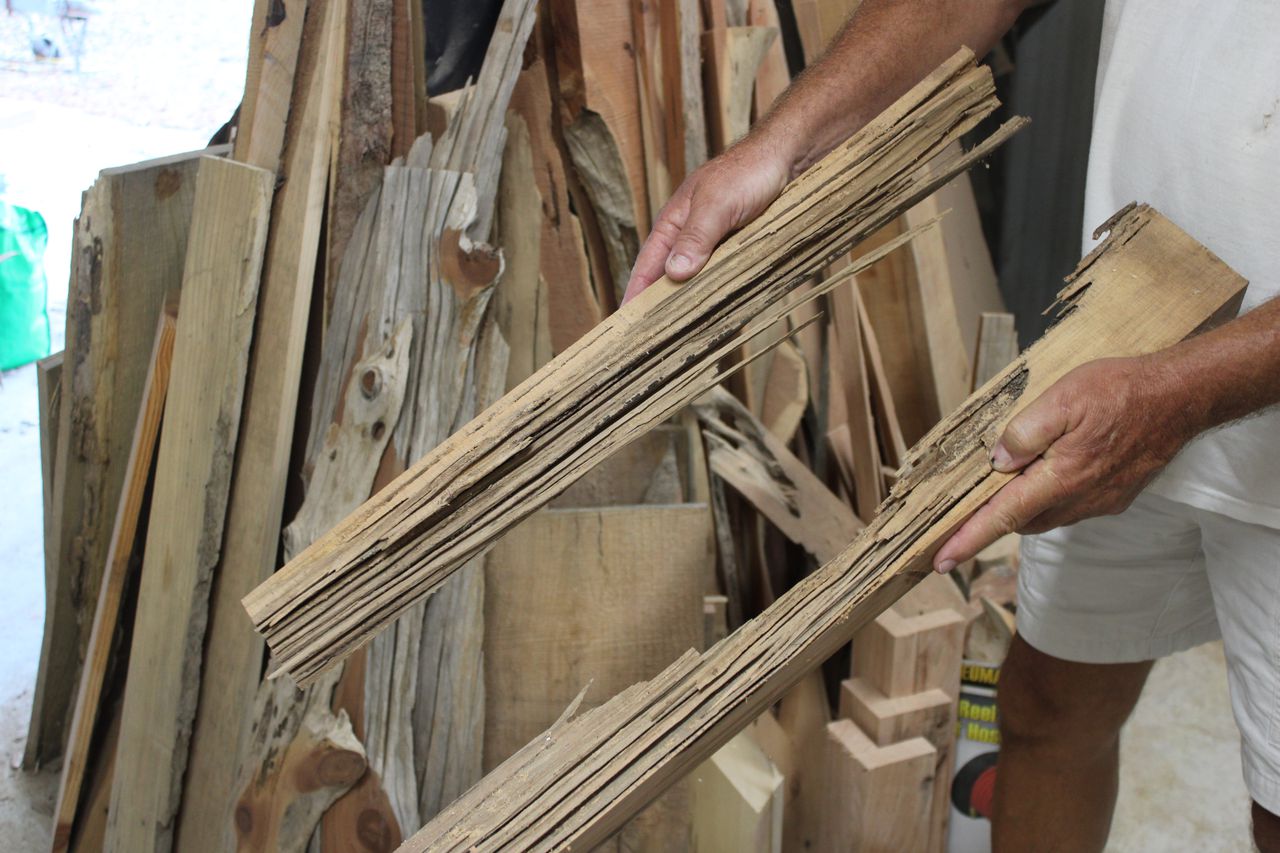Sawmill âpiddlingâ turns Mobile Bay driftwood into exquisite lumber
The two hunks of wood in Richard Kimbrell’s hands are so weathered, so fragmented, so eaten by insects or worms that they’re fraying apart in long splinters. But he sees something, when he holds them together just so.
“I can do something with that,” he says.
There’s lots of evidence around him to suggest that he can. A few years ago, as he began to think about retirement, he latched onto a hobby that connected him to family history. Now he specializes in taking battered logs that wash up on the shores of Mobile Bay, or sections of trees knocked down by storms such as Hurricane Sally, and finding treasure inside them.
“You don’t know what it is until you cut it,” he said of the “beach wood.” “The good wood is cypress, hickories, walnuts. All these really nice expensive species of wood that come down the river.”
His workshop is full of finds: Massive beams of old oak, covered in rune-like tracks eaten by worms. Slabs of cypress that have spent who knows how long immersed in the waters of the Mobile-Tensaw Delta, the naturally light wood absorbing color from the mud around it. Cedar and other species that may be dull on the outside but which explode with color when finished. The floor is stacked with character-rich bookmatched planks, sawn from one piece and opened like the pages of a book so that the patterns of grain and knotholes and fissures form a mirror image when these pieces are bonded edge-to-edge with clear epoxy filling the gaps. The shredded pieces he holds likely will get the same treatment: Cut from the same piece, flipped and turned to face each other edge to edge, their solid edges will form the sides of a piece whose clear epoxy middle freezes time, displaying the ruin left by its passage.
Sawmill operator Richard Kimbrell holds two pieces of wood that can be combined into a solid piece with clear epoxy.Lawrence Specker | [email protected]
He looks around at the enterprise he calls “this mess.” As in, “This mess appeared here about four years ago.”
Make that about five years ago. He’s a member of Buccaneer Yacht Club, which has a section of Mobile Bay shoreline that tends to accumulate washed-up logs, especially after big storms. Kimbrell said he was helping move logs when his wife, Sheila, asked if the wood might be good for anything. He thought it over and came back later with a drill to take some core samples, see if there was anything solid under the beat-up driftwood exterior. The results were promising.
Things started to crystallize around his wife’s simple question. As an engineer working in electrical automation for Hargrove & Associates, he’d spent a lot of time traveling to work on major projects for clients such as the Southern Co. and Evonik. But he was starting to think about retirement, especially after a back injury that left him with pain that flared when he spent time sitting in front of a computer, but which eased when he was active. Family history loomed large, too: From the late 1800s through the early 1950s, the Kimbrell family operated mills across southern Mississippi.
So he bought a portable sawmill, the kind of thing “made for people building things in Alaska,” he says. A 14-horsepower Briggs & Stratton engine runs a horizontal bandsaw. They’re both held in a carriage that rolls along steel rails over a wood-timber bed. The log sits still as the operator pushes the saw along. It’s no louder than a lawnmower. “$4,000, you can have one just like that, brand-new,” he says.
He started cutting lumber for construction property on his place near Fowl River and his daughter’s nearby lot. “We built barns, we built all kinds of stuff out of the lumber I got from around here,” he says. “Mainly pines and oaks and stuff. In the beginning it was all beach wood from the yacht club.”
But some of that wood turned out to be much too fine to be cut into two-by-fours. The hobby kept snowballing. He finally retired about a year ago. “I don’t know how I did this with traveling all over the country and all over the world doing my engineering work,” he says.
Four years after he started, things have sprawled far beyond what most people would class as a hobby. The sawmill has its own open-air shed, flanked by a pile of irregular slabs shaved off logs as Kimbrell squared them up and turned them into lumber. Nearby, another open shed covers planks that will spend six or eight months drying out enough to become stable. After that they go into a big metal-sided warehouse-type building that houses the ready-to-use wood, the workshop and the finished projects awaiting delivery.

Richard Kimbrell said one of his recent finds is a lot of blackjack oak, a species he says is rare in the Mobile area, that had been cut for use as firewood. At upper left is a rough-cut unfinished board. At upper right is a slab that has been lightly sanded, so that its patterning begins to show. At bottom is a finished tray made from the same “firewood.”Courtesy of Richard Kimbrell
Then there’s the trailer used to haul logs and equipment, the tractor and the forklift used to move logs around, and the colossal commercial-grade truck used to tow the trailer and Kimbrell’s RV. A previous owner customized the truck to pull Mardi Gras floats in New Orleans. It had a conventional pickup bed with a stripper pole in it. Now it’s got a flat bed and running boards custom-made from Kimbrell’s wood. The panel at the back of the cab has his logo and is striped with pignut hickory, red cedar, cypress and white oak. He’s easy to find at craft shows, like the ones he regularly participates in on Dauphin Island. Just look for the big blue truck.

Richard Kimbrell’s sawmill was designed to be portable and to work off its own power supply. A 14-hp motor drives a bandsaw, which moves on a carriage mounted to steel rails.Lawrence Specker | [email protected]
You’d think the point at which you need a forklift is the point where you’d admit that something is no longer a hobby. But Kimbrell, 63, still likes to say he’s “just piddlin’.”
And what he calls his “mess” has become a wonderland for any aspiring woodworker, for artists in need of raw material, or anyone looking for a mantel that can lend a sense of historical heft to a home.
“Nearly everybody on Fowl River has one of my mantels,” he says. “I’ve got lots of mantel material. They’ll take down a mantel to put one of mine up. Because now it’s a conversation piece, and it has a history behind it.”
Among the things that catch the eye: A huge beam of wildly pattered Grand Bay pecan that came down in a storm, destined to be part of a million-dollar home being built near the site where it grew. Slices of ripple-toned blackjack oak that were saved from being used as firewood. A work in progress, a slab of red cedar being turned into a coffee table. Most folks would slice this chunk thinner and make three or four coffee tables, but this is going to be one massively hefty piece. “That’s what people want,” Kimbrell says. “They want different things. Something nobody else has.”
Under a protective blanket there’s a glossy tabletop that looks like nothing else in the room, more like polished semiprecious stone than wood. That’s local cottonwood. “This tree came down right up the road here,” Kimbrell says. “The people’s parents planted this tree 40 years and it came down in Hurricane Sally. They wanted something made out of it. … That’ll be a table that’ll be a family heirloom.”

Some of the most impressive pieces of wood reclaimed by Richard Kimbrell are massive beams and slabs of “beach wood.” At left is a worm-eaten beam of hickory. In the center is a beam of red cedar. At right is a slab of cypress, its color darkened by the time it spent submerged.Lawrence Specker | [email protected]
Among the big timbers, a twelve-foot long, two-inch-thick slab of cypress that spent untold years submerged in the delta or the bay before being dislodged to wash up on the shore. It’ll probably become a mantel. “That’s what everybody wants, that sinker cypress,” Kimbrell says. “I could sell it just like that for about $1,500.”
Kimbrell isn’t immune to the siren song of such pieces. In addition to the pieces he cuts to order and finishes for customers, he creates plenty of his own: book stands, laminated cutting boards, tables and more. He sells them at craft shows. He frequently participates in shows on Dauphin Island, most Thursdays and some Saturdays.
There hasn’t been enough time for that lately. “I’ve got so many orders right now from people that my piddlin’ time is not piddlin’ anymore,” he says. “When I get these out the door, I’ll have my piddlin’ time back.”
As he guides a guest through his warehouse, something becomes clear: He’s spent so much time watching artists pick out pieces for projects that he’s started to look at the pieces with an artist’s eye.
He points out a piece of cedar with a split that suggests an alligator’s mouth. “Give that to an artist, they’ll make something out of it,” he says.
He considers another slab. “Somebody will see something in that,” he says. It’s a little harder to define, but the sense of potential is there.
“Maybe it’ll take a couple of beers to see it,” he says, “but somebody will see it.”
Richard Kimbrell posts updates on his projects on a Facebook page titled “4G Kimbrell Sawmill Since 1891.” The best way to reach him is via Facebook Messenger.
